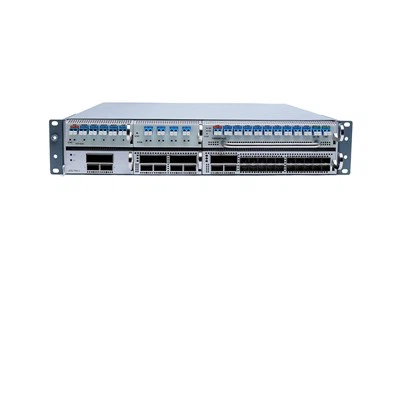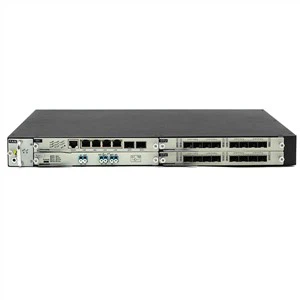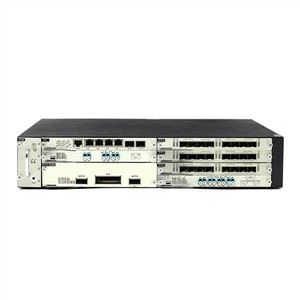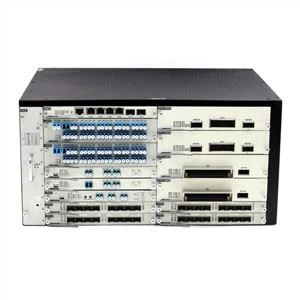51. FA Frequency agility
Refers to the ability of the transmitting system to automatically hop to adapt to the environment according to changes in external conditions.
52. CSMF Common Single Mode Fiber
A single-mode fiber that meets the requirements of ITU-T.G.652, often referred to as a non-dispersion-shifted fiber, has a zero dispersion in the low-loss region of the 1.3um window and operates at a wavelength of 1310 nm (loss of 0.36 dB/km). With the successful advancement of the fiber optic cable industry and semiconductor laser technology, the operating wavelength of the fiber line can be transferred to a lower loss (0.22 dB/km) 1550 nm fiber window.
53. DSF Dispersion-Shifted Fiber
A single-mode fiber that meets the requirements of ITU-T G.653 has a zero-dispersion wavelength shifted to a very low loss of 1550 nm.
54. GE Gigabit Ethernet
The Gigabit Ethernet standard was officially launched in October 1997 with a maximum transfer rate of 1 Gbps and is backward compatible with Ethernet technology and Fast Ethernet technology.
55. GIF Graded Index Fiber
Light travels in a sinusoidal shape with a bandwidth of 1-2 GHz.km, which is used for some LANs that are not too fast.
56. GS-EDFA Gain Shifted Erbium-doped Fiber Amplifier
By controlling the degree of particle inversion of the doped fiber, the 1570-1600 nm band is amplified, and it can be combined with a common EDFA to obtain a broadband amplifier having a bandwidth of about 80 nm.
57. GVD Group Velocity Dispersion
In high-speed and large-capacity optical fiber communication, the shape of the optical pulse envelope changes due to the nonlinearity of the optical fiber medium. This change affecting the reception of the optical signal is called group velocity dispersion, and the group velocity dispersion causes the transmission waveform. Broadening. G.654 Cut-off wavelength shifting single-mode fiber This focus of fiber design considerations is to reduce the rate of 1550nm. The zero dispersion point is around 1310nm, so the dispersion at 1550nm is higher, which can be greater than 18ps/(nm.km). A single longitudinal mode laser can be used to eliminate the effects of dispersion. It is mainly used for submarine communication fiber communication with a long regenerative distance.
58. HPF High Pass Filter
It’s a filter that allows radio waves that exceed a certain frequency to pass almost without attenuation, while other waves below this frequency band are severely attenuated.
59. HRDS Hypothetical Reference Digital Section
It is a degree model with a certain length and performance specification, which can be used as a reference model for indicator allocation. For the SDH number field, there are three lengths of 420km, 280km and 50km.
60. IDLC Integrated DLC
Broadband active optical network, ie Integrated Digital Loop Carrier System (IDLC) is a transmission platform based on SDH or PDH, which can provide PSTN, ISDN, B-ISDN, DDN, LANE, Internet and digital video services for centralized user areas. Access is also an ideal way to integrate broadband access and has great potential for development.
61. IDEN Integrated Digital Enhanced Networks
The iDEN system was introduced in Los Angeles in 1994. It is a digital cluster system proposed by Motorola. It works in the 800MHz frequency range. After about three years of promotion, it has been put into commercial application in 13 countries in North America, South America and Asia. Its main feature is that it can be compatible with GSM, suitable for large networks and more suitable for PAMR applications.
62. IEEE 802.3
CSMA/CD LAN, the Ethernet standard.
63. IEEE 802.11
The wireless LAN technology standard promulgated in 1997, the IEEE 802.11 specification defines three physical layer (PHY) options: infrared, direct sequence spread spectrum (DSSS), and frequency hopping spread spectrum (FHSS). Since the wireless LAN transmission medium (microwave, infrared) is very different from the wired medium, there are some new technical problems objectively. For this reason, the IEEE802.11 protocol specifies some crucial technical mechanisms such as CSMA/CA protocol, RTS/ CTS protocol, etc. In August 1999, the 802.11 standard was further refined and revised. Two new contents, 802.11a and 802.11b, were added, which expanded the standard physical layer and MAC layer specifications.
64. Jitter
One of the important transmission characteristics of the SDH optical transmission network is defined as the short-term deviation of the effective moments of the digital signal from the theoretical specified time position.
65. K Band K
10G-12G for satellite communications.
66. Ku Band Ku
12G-14G for multi-satellite communication.
67. LA Line Amplifier
An optical amplifier that compensates for fiber loss on the trunk line.
68. LEAF Large Effective Area Fiber
Single-mode non-zero dispersion-shifted fiber, working in the 1550nm window; compared with the standard non-zero dispersion-shifted fiber, it has a larger “effective area” and the effective area is increased to 72um2 or more, thus a large power bearing capacity. For the use of high output power doped fiber amplifiers, namely EDFA and dense wavelength division multiplexing technology networks.
69. LANE LAN Emulation
When ATM switching is exchanged with Ethernet, a simulation process for ATM cells is required.
70. LMDS Local Multipoint Distribution Service
A very popular broadband wireless access system that utilizes spread spectrum and polarization techniques. The base station covers approximately 2-10 KM and can provide up to 4.8 G of bandwidth. Suitable for wireless access in densely populated areas.
71. LOF Loss of Frame
After the frame out-of-synchronization state lasts for 3 ms, the SDH device should enter the frame loss state; and when the STM-N signal is continuously in the fixed frame state for at least 1 ms, the SDH device should exit the frame loss state.
72. LOS Loss of Signal
When the received optical signal power is always below a certain threshold value Pd (Pd corresponds to BER ≥ 10-3) for a given time (10 us or longer), the device enters the LOS state.
73. LOP Loss of Pointer
When no valid pointer is found for 8 consecutive frames, or 8 consecutive new data flags (NDF) are enabled, the device should enter the LOP state; and when 3 consecutive valid pointers or cascade indications with normal NDF are detected. This device should exit the LOP state.
74. MI Modulation Instability
Modulation instability instantaneously breaks a continuous wave (CW) signal or a pulse, making them a modulated shape. A quasi-monochromatic signal spontaneously produces two symmetric frequency sidebands. This phenomenon may be observed in areas above the zero dispersion wavelength.
75. MLCM Multi-Level Coded Modulation
A complex code modulation method can be regarded as a delete trellis coded 64QAM mode. The design idea is the same as TCM, which brings the redundancy generated by the error correction code to the most error-prone symbols to maximize the coding redundancy.
76. MMF Multi Mode Fiber
Two or more modes of fiber can be propagated at the wavelengths considered.
77. MMDS Multichannel Multipoint Distribution Service
Often referred to as a wireless cable, a wireless system is typically used to transmit image traffic.
78. MVDS Multipoint Video Distribution Service
A wireless local loop technology developed by the UK, running at 40.5G to 42.5G, is very similar to LMDS, but is mainly used in video on demand services.
79. MQAM Quadrature Amplitude Modulation
Multi-ary quadrature amplitude modulation is a carrier control method widely used in medium and large-capacity digital microwave communication systems. This method has a high spectrum utilization rate. When the modulation number is high, the distribution of the signal vector set is also reasonable, and it is also convenient to implement. At present, 64QAM, 128QAM, etc., which are widely used in large-capacity digital microwave communication systems such as SDH digital microwave and LMDS, belong to this modulation mode.
80. MSOH Multiplex Section Overhead
Responsible for managing the multiplex section, which can only be accessed at the terminal device.
81. MSP Multiplexer Section Protection
A protection method for SDH optical fiber communication, the service volume of protection is based on the multiplex section, and the switching is determined according to the merits of the multiplex section signal between each node. When the multiplex section fails, the multiplex section service signal between the entire nodes is turned to the protection section.
82. MZ Mach-Zehnder
The modulator splits the input light into two equal signals into the two optical branches of the modulator. The materials used in these two optical branches are electro-optic materials whose refractive index varies with the magnitude of the externally applied electrical signal. Since the refractive index change of the optical branch causes a change in the phase of the signal, when the output ends of the two branch signal modulators are combined again, the synthesized optical signal will be an interference signal of varying intensity, equivalent to the electrical signal. The change is converted into a change in the optical signal, and the modulation of the light intensity is achieved.
83. NA Numerical Aperture
It indicates the ability of the fiber to receive and transmit light. The larger the NA, the stronger the ability of the fiber to receive light, and the higher the coupling efficiency from the source to the fiber.
84. NC Network Connection
Network connections are cascaded by subnet connections and/or link connections and can be seen as an abstract representation of this complex entity. It transparently delivers end-to-end information over a layer network, delimited by a terminal connection point (TCP).
85. NEL Network Element Layer
The most basic management layer is responsible for the management of configuration, fault, and performance of a single network element.
86. NML Network Management Layer
Manage, monitor, and control the network areas of different manufacturers.
N87. E Network Element
The basic unit that constitutes the network.
88. NZDSF Non Zero Dispersion Shifted Fiber
Single-mode fiber that meets ITU-TG655 requirements is a dispersion-shifted fiber, but the dispersion is not zero at 1550 nm (according to ITU-TG655, the dispersion value in the range of 1530-1565 nm is 0.1-6.0 ps/nm. Km) to balance nonlinear effects such as four-wave mixing. Commercial fibers are like TrueWave fiber from AT&T, Corning’s SMF-LS fiber (which has a zero-dispersion wavelength of 1567.5 nm, a typical zero dispersion of 0.07 ps/nm2.km) and Corning’s LEAF fiber.
89. NNI Network Node Interface
It can be a simple node with only multiplexing functions, or a complex node with transmission, multiplexing, cross-connect, and switching functions.
90. OADM Optical Add Drop Multiplexer
Its function is to select the optical signal from the transmission device to the local optical signal, and to send the optical signal of the local user to the user of another node without affecting the transmission of other wavelength channels, that is to say, the OADM is realized in the optical domain. The function of the electrical add/drop multiplexer in the traditional SDH device in the time domain.
91. OA&M Operations, Administration and Maintenance
A set of network management features for network performance monitoring, failure detection, and system troubleshooting and protection.
92. OFA Optical Fiber Amplifier
It refers to a new all-optical amplifier used in fiber-optic communication lines to achieve signal amplification. According to its position and role in the fiber line, it is generally divided into relay amplification, preamplification and power amplification.
93. ODN Optical Distribution Network
Optical distribution network, consisting of passive optical components
94. OAN Optical Access Network
Access network technology based on optical transmission
95. OBD Optical Branching Device Optical Splitter
Passive optical power splitter (coupler) that distributes the downlink signal and couples the upstream signal
96. OLT Optical Line Terminal
Provides an interface between the network side and the local switch, and connects one or more ODN/ODTs to communicate with the ONUs on the user side.
97. ONU Optical Network Unit
Provides a user-side interface for the optical access network and is connected to one ODN/ODT.
98. OFS Out of Frame Second
A second with one or more OOF events is called OFS.
99. OM Optical Multiplex
Multiple wavelengths are multiplexed into one fiber for transmission.
100. OMSP Optical Multiplex Section Protect
This technique only performs 1+1 protection on the optical path without protecting the terminal equipment. A 1×2 optical splitter or optical switch is used at the originating end and the receiving end respectively, and the combined optical signal is separated at the transmitting end, and the optical signal is selected at the receiving end. Optical multiplex section protection is only practical if implemented in two separate optical cables.





















